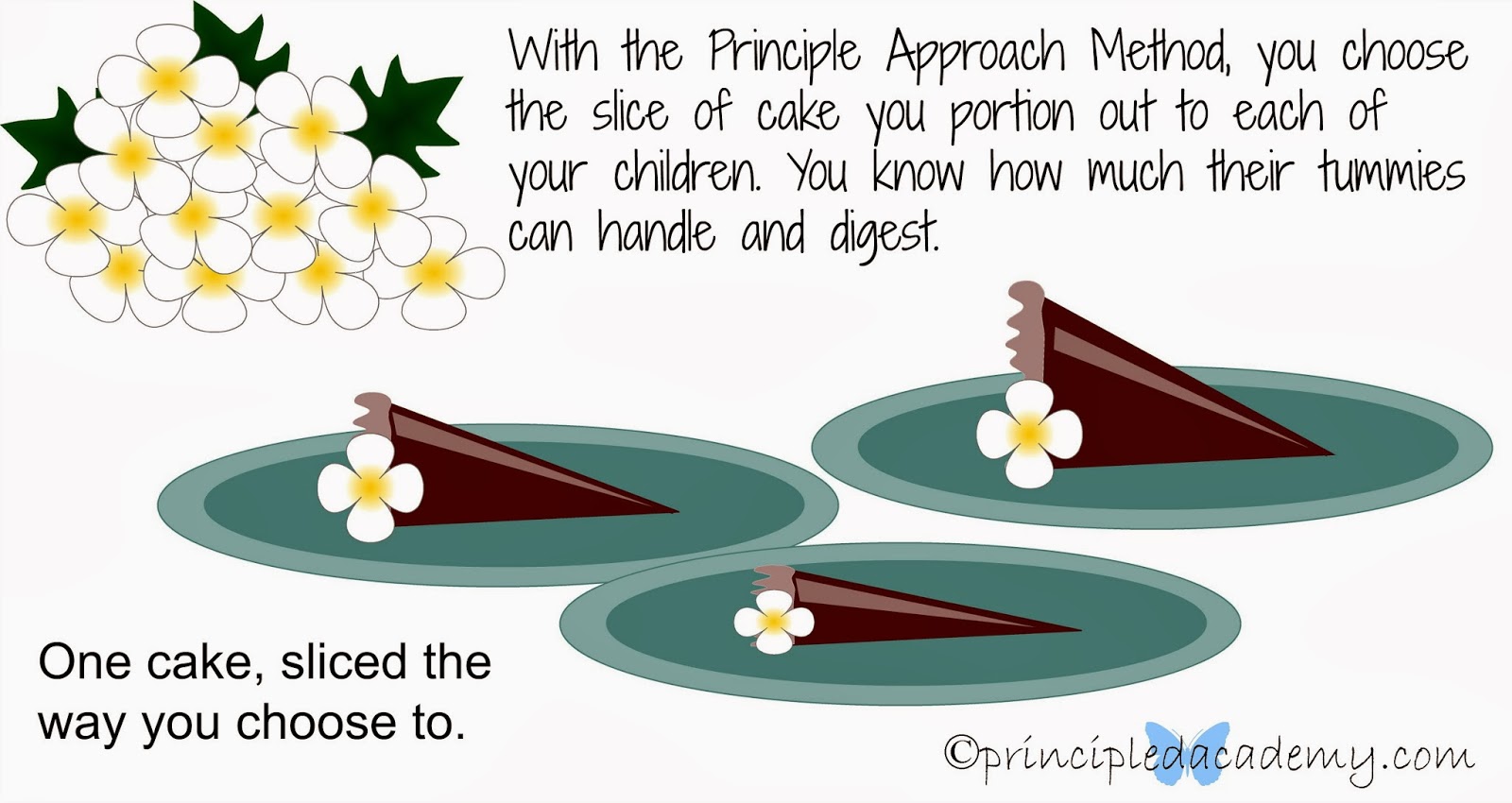Whether you use a pre-boxed curriculum or you are baking your curriculum from scratch, the Principle Approach can be applied.
You are about to enjoy the most delicious form of education. You are going to gather all of the necessary ingredients, prepare you cake, sit down with your children and enjoy eating of it together. Let me show you how!
Ingredients:
A teachable spirit
A love for the Lord
Living books, text books, the world around you
An Idea/Philosophy to pull from these books to test against Scripture.
The Bible
Webster's 1828 Dictionary
The Blue Letter Bible
Recommended but Optional: The Noah Plan Curriculum Guides, The Noah Plan Curriculum K-3rd, The Noah Plan Curriculum Overviews for 4th-12th, The Red Books (These can all be found at this store here.)
The First Layer:
Both of these are overarching- they are not confined by grades. These are the foundation of your lesson- that's why they are the first layer of your cake (the cake represents your lessons).
Your Leading Idea is your theme and the Bible Principle supports your theme. The Bible Principle is either a verse of your choosing (in context of course) or one of the 7 Bible Principles which The Foundation For American Christian Education focuses on each school year.
You can teach the same Bible Principle for the same topic in your lesson to children of various ages.
The Second Layer:
Your second layer is the content which correlates with your Leading Idea and Bible Principle. This can be pulled from living books (literature) you will be reading, a film you watch, the world around you, history, your Noah Plan lessons/overviews, lessons you make from scratch, or a boxed curriculum of your choice.
The Third Layer:
Your last layer is the 4R Method. This is where it gets rich. You see, this layer is full of nutrients for your noggin (hey, it's a health-nut cake, okay?). ;-)
You've got ideas, actions, attitudes, philosophies, etc. to research. So you dig in and research words in Webster's 1828 Dictionary. Define those words and their key words. This gives you correct understanding of definitions and also gives you a nice list of words to research in the Bible. As Christians, it's important to us to know and understand what the Word of Yahweh teaches us.
Then you're going to reason from Scripture with your children. Next, you are going to relate. Lastly, you will record what you learn. This may be done by journaling, creating a video, memorization, etc. It's up to you!
But wait, Heather!!!
That's an awfully large cake ya got there! Not everyone has tummies that can hold all of that food!
Portion Out Slices of the Cake:
It's okay. You, the baker, get to decide what size of a slice to portion out per student. As you go through the lesson planning process, you choose how big of a slice each of your children can eat. Little slices for littler tummies to digest. Medium sizes for those medium sized tummies to digest. Large slices for the larger tummies to digest. You'll get it juuuuuuust right for them. (Hey, how did Goldie Locks and the Three Bears sneak into this?)
In other words, as you go along teaching the content, you pause where you see fit for your younger ones. They have the information you want them to know/they need to know. This is their little slice of cake for their littler tummies. They can begin working on their notebook pages (illustrating, jotting down notes, crafting the lesson, etc.). While they are busy "eating their slice of cake, " they will still hear you go on with the lesson on a deeper level with your next oldest children. And so you continue until you are finished delivering the lesson to your oldest child.
So, now I need feedback from you all. Does this help you to understand how to teach multiple ages/abilities with the Principle Approach at one time? It's a time saver! If I can clarify anything, please let me know and I'll do my best!
Blessings!
You can follow Principled Academy on facebook here, on Pinterest here, or on Twitter here!
Thank You!







This is the best "How-To" of the Principle Approach I have seen! I am researching and learning more about this method of teaching and it always seems very complicated. Your explanation really helps me to see where I need to go in my planning, now. It also helps me in creating a lesson planner..I wonder if I should create one in the shape of a cake ;) Thank you!
ReplyDeleteI'm so thankful it has helped you to understand the Principle Approach! Thank you for visiting and taking the time to let me know this has blessed you. I hope you enjoy using this method in your home and pray you enjoy the Spiritual growth with your family. Blessings to you!
DeleteHi heather! When you're teaching multiple kiddos at once, which of the Bible Principles do you base the lesson on? As I'm gearing up to teach a first grader and kindergartener, I'm seeing they each have a different foundational Principle for the entire year. I do like the idea of everything throughout the year reinforcing that same principle, but I'm also VERY much liking the idea of one lesson for all the kids, lol. So, I'm torn on how to implement this. Thank you! ...Tracey Roberts
ReplyDeleteHi Traci! Thank you for your question. If you have already covered the Kindergarten curriculum with your oldest child, I think that you can easily adapt the First Grade lessons for your Kindergartner (or vise versa).
DeleteI'm still writing curriculum based off of the 6th grade NP overviews and it's going well for me with my Kindergarten through High School students. The principles are overarching and I modify the lesson work according to their abilities.
Please let me know if you have any other questions or would like to bounce ideas around.
Blessings!
Heather